Experimental evaluation of four types of 2x hulls

In November, a
biomechanical comparison was conducted to determine the hull efficiency of
several different boats. The method came in the form of two-boat side-by-side
trials, which eliminated the effect of weather conditions, based on the
assumption that the wind speed and direction were the same for both boats. Four
boats (double sculls) were compared:
·
WinTech new
2019 for 90-105kg (WT new);
·
WinTech older
2012 for 90-105kg (WT old);
·
Empacher 2015 for
75-90kg (R34 C060);
·
Filippi 2015 for
72.5kg (F13CB41Z).
All hulls were of 27kg mass
(WT new was 27.5kg); the first three doubles had aluminium
stern-mounted riggers, with the Filippi having carbon bow-mounted
riggers. The span was set to 1.60m in all boats. Four sets of identical
sculling oars were used (Concept2 Skinny Smoothie-vortex
blade), all with inboard 0.88m and length 2.885m. Four scullers took part
in the study, which allowed two constant crews:
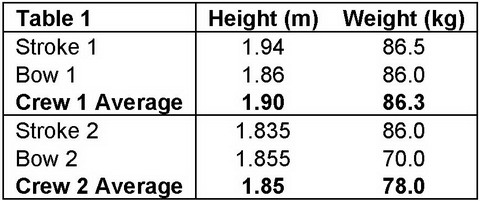
The main purpose of the
experiment was to compare the new WinTech hull with three other boats: the
experiment consisted of three rounds, each round containing two trials, where the
WT new hull was rowed by Crew 1, and another other hull – by Crew
2. The crews then swapped boats over and repeated the trials. In this way, the
evaluation of the hull didn’t depend on the weight and rowing technique of the
crew. Six 1000m trials were made altogether with two boats running parallel in
the following order:
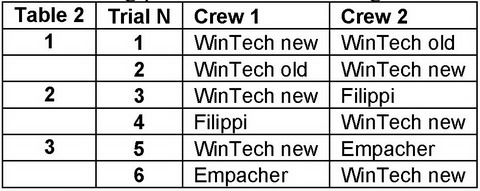
Each 1000m trial was
performed with incrementally increasing stroke rate with the following five
sections:

The weather conditions
were very good for this sort of experiment: practically no wind, with an
occasional light cross-head wind and showers, a temperature of 10-11deg C, and
flat clean water at the Eton Dorney Olympic rowing course.
All four boats were
equipped with BioRowTel systems (32 data channels each, 14 bit, 25 Hz), which
measured the following biomechanical variables:
• 2D oar angles in horizontal and vertical planes,
• Handle force from all 4 oars,
• Seat movement of each rower,
• Rowing speed with a 10Hz GPS of each boat,
• 3D hull accelerations from each boat,
• 3D hull rotations with gyroscope.
Data samples were selected
based on consistent stroke rate in each of five target sections (S01-S05)
in each of the six trials. The data in each sample was averaged and typical
patterns representing one stroke cycle were obtained. Additionally, the whole
1000m trial was selected as a data sample, and average patterns were obtained. The
following main indicators were calculated from the typical patterns and then
compared and analysed:
· Average rowing (boat) speed Vav
(m/s),
·
Stroke
length – Total oar angle Atot (deg)
swept over the stroke cycle,
·
Average
force applied to the handle Fav (N)
over the drive phase,
·
Work per
stroke WpS (J) over the stroke cycle,
·
Rowing
power P (W) over the cycle/sample;
· Waste power lost in blade slippage through the
water Pw, Propulsive power Pprop = P – Pw and Blade
efficiency Ebl = Pprp / P;
·
Gross
rowing drag factor DFg - a ratio of the power P to
the cube of average speed Vav over each sample: DFg = P /
Vav3;
· Net rowing drag factor DFn - a
ratio of Pprop to the average of cubes of the instantaneous boat velocity
Vi over the stroke cycle: DFn = Prop / average(Vi3)
.
The difference between the Drag Factors (RBN
2015/04) is that the net factor DFn doesn’t depend on energy losses
in variation of the boat speed and blade slippage, but the gross factor DFg
does.
Results
The stroke rate (spm) maintained was very close to the targets in each section (averages of both crews in the two paired trials are shown here and below):
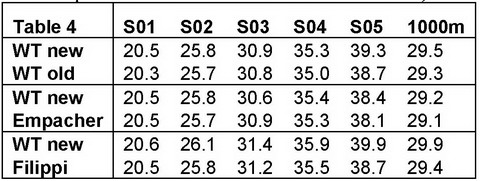
The average rowing speed (m/s) was higher with WT new hull in all samples except the lowest stroke rate (WT old), and three lowest stroke rates with Empacher (marked in red):

Rowing power (W) was fairly consistent:
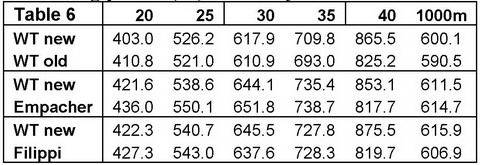
The Gross Drag Factor DFg was lower in the WT new hull in all samples, except stroke rates 25 and 30 in comparison with the Empacher hull.

The Net Drag Factor DFn was lower in the new WinTech hull in all samples at racing stroke rates 35 and 40spm, except 35spm with WT old:

As the WT new hull was shorter, it was suspected it may have higher pitch amplitude (deg) over the stroke cycle. However, it was found that WT new hull had about 10% less pitch amplitude compared to WT old and only 2-3% more compared to other boats:
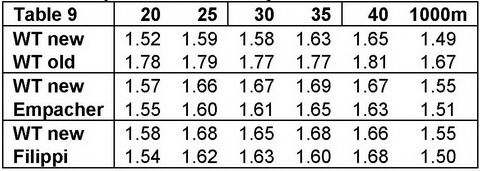
To verify the results of the experiment, the rowing indicators were averaged for each crew across the whole 1000m trial across all four boats they rowed in:
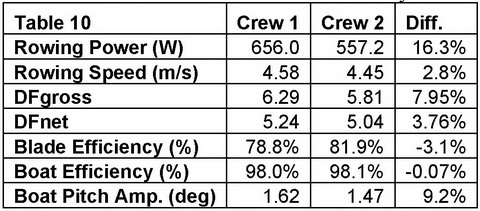
As expected, the heavier
crew 1 produced 16.7% more power and showed 2.8% higher rowing speed (Table 10). Both DFg and DFn were
higher in Crew 1, as expected: DFg was
7.9% higher, but the difference in DFn was only 3.8%, which
could be explained by the higher blade efficiency in Crew 2, and slightly
higher boat velocity efficiency, i.e. lower variation of the instantaneous boat
velocity over the stroke cycle.
It would be interesting to
compare the ratio of DFn to rower mass m found in
this study with the previous statistical data (RBN 2007/07), which relates it
for doubles/pairs as:
DFn = 0.020972m + 2.931142 (1)
With average crew mass 86.3kg for Crew 1 and 78.0kg for Crew 2 (Table 1), equation 1 gives DFn factors 4.74 and 4.57 respectively. This is slightly lower than in this study (Table 10), which may be related to weather conditions. However, the difference between DFn of the crews, 3.74%, based on equation 1 was very close to DFn 3.76% found in this study. This means every 1 kg of extra rower’s weight makes DFn 0.45% higher, and rowing speed 0.55s slower over 2km at the same rowing power.
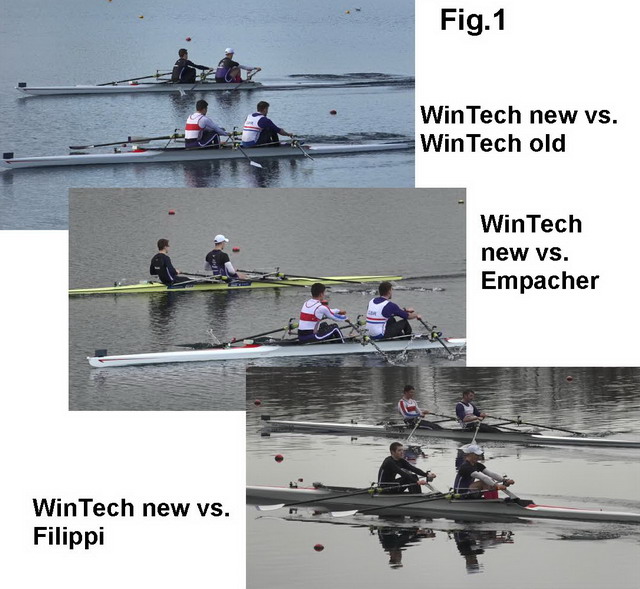
Conclusions
The results confirm that the new WinTech hull has a lower average drag factor compared to the older WinTech hull and hulls of other boat brands (Empacher and Filippi). Importantly, this advantage was the highest at the racing stroke rates 35-40spm.

Based on gross Drag Factors found at 35 spm and the target rowing power for Olympic level rowers (475W (Table 11)), it can be concluded that the new WinTech hull gives about 1% (3.7s over 2k) advantage over the old WinTech hull, 0.11% (0.4s) advantage over Empacher, and about 2,5% (9.3s) advantage over Filippi hull.
©2019 Dr. Valery Kleshnev www.biorow.com



